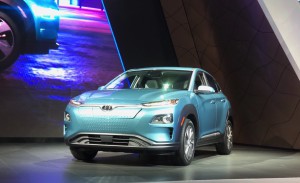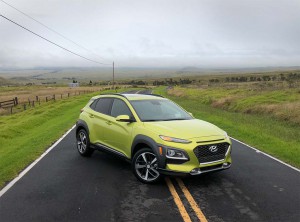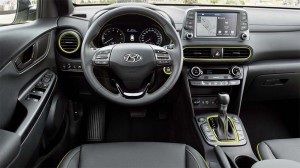
Hyundai wasted no time in getting the battery-electric version of its new Kona compact ute in front of the people.
The race to bring out affordable, long-range battery-electric vehicles is shifting into high gear, Hyundai among an assortment of manufacturers revealing new products – or laying out plans – at this year’s New York International Auto Show.
And the Korean carmaker wasn’t pulling any punches as it pulled the wraps off the Kona Electric, the battery-powered version of its new Kona sport-utility vehicle. During a media preview, Hyundai Motor America CEO Brian Smith pointed out that is rated at 250 miles per charge, more 12 miles than the Chevrolet Volt EV and 30 more than the Tesla Model 3.
Hyundai has, in fact, taken pains to tweak Tesla in recent weeks, warning the California carmaker it’s coming into the market with a billboard-sized banner that greeted visitors to the Geneva Motor Show earlier this month. In his Wednesday comments, meanwhile, Smith noted that Hyundai is “a company that meets its production deadlines,” a clear shot at Tesla’s ongoing production problems with the Model 3.
Visually, the Kona Electric is all but identical to the gas-powered version of the small ute that is just rolling into U.S. dealer showrooms. The most noticeable change comes up front, a solid fascia replacing the normal grille. Embedded in the nose is the Kona Electric’s charging port.
(To check out TDB.com’s first drive in the Hyundai Kona, Click Here.)

The Hyundai Kona was designed to ensure the BEV version had the same interior layout as the gas-powered model.
The battery-electric vehicle takes about 9.5 hours to fully recharge using a 240-volt Level 2 system, but it can also get an 80% top-off in about 30 minutes using a Level 3 quick charger.
The Kona Electric punches out 240 horsepower and 291 pound-feet of torque using a single electric motor that draws power from a 64 kilowatt-hour lithium-ion battery.
What’s particularly significant, Hyundai product planning chief Mike O’Brien pointed out to TheDetroitBureau.com, is that “there are no sacrifices.” Not only is performance comparable to the gas model using a 1.6-liter turbo engine, but also the Kona Electric retains the interior passenger and cargo space of the more mainstream model due to the way Hyundai has been able to tuck away the ute’s battery pack.
What is unclear is what the price will be for the BEV. The base version of the Kona starts just under $20,000, but the Electric is expected to carry a premium that would push it, at the least, up around what a buyer would pay for a well-equipped turbo all-wheel-drive version – and likely higher. COO Smith said a final figure hasn’t been determined and likely won’t be announced until shortly before the Kona Electric goes on sale in late 2018 as a 2019 model.
(Click Here for a review of the new Hyundai Nexo fuel-cell vehicle.)
By comparison, the second-generation Nissan Leaf and Chevy Bolt both start under $30,000 when factoring in the $7,500 federal tax credit – which Kona Electric will qualify for.
As with many recent all-electric models, the Kona will be fairly loaded with creature comfort and safety features, including LED headlights, Apply CarPlay, Android Auto and the extensive Hyundai Safety Sense system. That’s a package of technologies including forward collision warning with pedestrian detection and auto-braking, blind spot monitoring and rear cross-traffic assist.
Options include an 8-inch navigation display, rain-sensing wipers, Qi wireless smartphone charging and a heads-up display.
Industry analysts believe that the arrival of longer-range, more affordable electric vehicles could finally get reluctant consumers to start plugging in.
“When you get to 250 miles,” echoed Hyundai’s Smith, “people stop worrying about range anxiety,” the factor most often cited by potential buyers as the key obstacle to purchase.
(Hyundai is ready to debut a new-gen Santa Fe. Click Here for the story.)
How much of a market might there be for the Kona Electric? “We’ll start small,” said Smith, but other Hyundai insiders confided that the Korean carmaker has significant flexibility to meet demand if it starts to grow.

